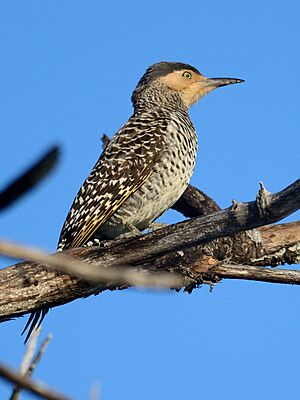Chilean flicker facts for kids
Quick facts for kids Chilean flicker |
|
|---|---|
 |
|
| Conservation status | |
| Scientific classification | |
| Genus: |
Colaptes
|
| Species: |
pitius
|
 |
|
The Chilean flicker (Colaptes pitius) is a type of bird that belongs to the woodpecker family. You can find this bird in Argentina and Chile.
Contents
About the Chilean Flicker's Family
The Chilean flicker was first named Picus Pitius. For a while, it was the only bird in its own special group called Pituipicus. Later, this group was joined with the Colaptes group. The Chilean flicker and the Andean flicker are like close cousins in the bird world.
The Chilean flicker is the only one of its kind in its specific group, meaning it doesn't have any close relatives that are different species.
What Does the Chilean Flicker Look Like?
The Chilean flicker is about 30 cm (12 in) long. It usually weighs between 100 and 163 grams (3.5 to 5.7 oz). Male and female flickers look very similar, except for some small differences on their heads.
Adult males have dark gray feathers from their forehead to the back of their neck. Sometimes, the back of their neck might have a tiny bit of red. Around their eyes and cheeks, they are a light yellowish-brown color. They have small black or black and red spots on their cheeks. Their chin and throat are whitish with black spots.
Female flickers have yellowish-brown cheeks with no spots, and they never have red on the back of their neck.
Both male and female flickers have dark brownish-black feathers on their upper bodies with thin white or yellowish-white stripes. Their lower back is white, sometimes with a few black spots. Their wing feathers are dark brown. Their tail is brownish-black on top, with thin white stripes on the middle and outer feathers. The underside of their tail is yellowish with faint stripes. Their bellies are whitish with wide brownish-black stripes on their chest, and their lower belly is mostly plain.
Their long beak is black. Their eyes are whitish to yellowish, and their legs are gray or greenish-gray. Young flickers look a lot like the adults, but they have brown eyes, a darker head, wider stripes on their back, and more spots on their belly.
Where Does the Chilean Flicker Live?
You can find the Chilean flicker in central and southern Chile. It also lives in nearby parts of southwestern Argentina.
This bird prefers places with a mild or Mediterranean climate. It likes open areas or places that are partly open. This includes the edges of forests, open woodlands, and areas with trees near rivers. They also live in tree farms and bushy areas. They usually live at heights between 600 and 1000 meters (2,000 and 3,300 ft) above sea level. However, in winter, you might find them closer to the ocean.
How Does the Chilean Flicker Behave?
Movement
The Chilean flicker usually stays in the same area all year round. However, it might move around a little bit within its home range.
Feeding
The Chilean flicker mostly eats adult ants, their young (larvae), and their cocoons (pupae). They often look for food in family groups, usually on the ground. They hop around, poking, digging, and moving leaves or other things out of the way. They will also check fallen logs and tree stumps for food, but they rarely look for food in trees.
Breeding
Chilean flickers are thought to breed between October and December. They dig a hole for their nest in a dead tree or a tree stump. Sometimes, they even dig nests in dirt banks. They are believed to be very protective of their nesting area. A female flicker usually lays four to six eggs. We don't know how long the eggs take to hatch, or when the young birds leave the nest.
Vocalization
The Chilean flicker makes several different sounds. These include a long "wic wic wic" series of calls. They also make a whistling sound that can be a single "kwee" or a series of them. Another call sounds like "week-a, week-a".
Is the Chilean Flicker in Danger?
Experts from the IUCN (International Union for Conservation of Nature) say that the Chilean flicker is a species of "Least Concern." This means it is not currently in danger of disappearing. It lives in a very large area, and even though we don't know the exact number of birds, their population seems to be stable. There are no immediate threats to this bird. It lives in several protected areas and is considered quite common.




